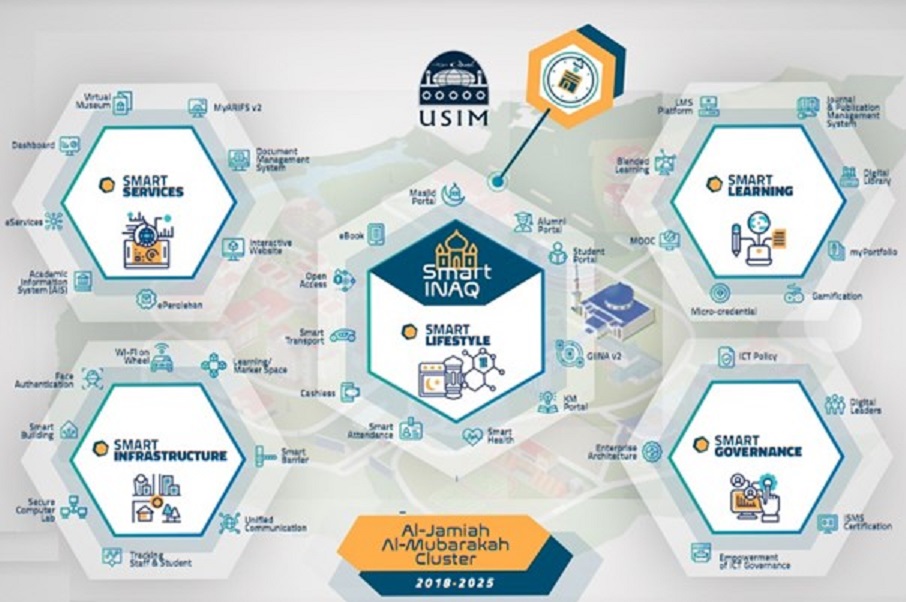NILAI- It has been more than 365 days since the first case of COVID-19, and much has changed worldwide. Adapting to a new world, we have learned a great deal about the spread of COVID-19, are aware of the implications and have introduced mitigation solutions within societies and with regard to our economies. Yet worldwide, we are still learning. The new normal is not only about introducing social distancing practices or practicing good respiratory etiquette; it is all about our ethical manners in terms of supporting government initiatives and strategies when it comes to combating COVID-19. Thus, Universiti Sains Islam Malaysia (USIM) has launched our first strategic Smart Universities Blueprint entitled Al-Jamiah Al Mubarakah, to navigate the ‘new normal’ until 2025. With the launch of this blueprint, we demonstrate that we are increasingly tech-driven and ready to adapt to the new normal.
The Al-Jamiah Al Mubarakah blueprint introduces five (5) clusters and 13 initiatives for digital transformation in order to support business operations at USIM. Furthermore, this blueprint is based on seven (7) principles taken from our ICT Strategic Plan (ISP) 2021-2025 which emphasize and are based on Maqasid Syariah, the Industrial Revolution, Student-Centric, Data-Driven, Open Source, Agile and Mobility and Prosumerism. In this blueprint, there are five (5) clusters in the form of smart INAQ (smart lifestyle), smart governance, smart infrastructure, smart learning and smart services.
The smart INAQ is based on a student-centric and data-driven approach, in order to create and collect data, derive insights from that data, and utilize these insights for visual analytics and knowledge sharing. It fosters a digital and mobile culture in terms of mosque management, health, transportation, donations (waqf and infaq), knowledge, personal data, academic achievement and lifestyle. This includes smart attendance, e-wallets (cashless campus), smart transport, ebooks, open access, smart health, and a masjid portal which can be accessed through mobile applications.
To drive the digital transformation at USIM, it is necessary to empower the ICT governance via Smart Governance. The digital transformation is supported in terms of inspiration, the empowerment of ICT governance and ICT policies, molding digital leaders, the execution of Enterprise Architecture, and compliance with the Information Security Management System (ISO 270001). As a result of the synergistic cooperation between the Chief Information Officer (CIO) Unit and the System Development and Engineering Centre (SDEC), a series of Tech Talks, industry collaboration, certified and certification of professional bodies, prosumerism enculturation, and tech-driven awareness, will be executed in the immediate future and until 2025. Digital leadership is a combination of the leadership style of transformation leadership and the uses of digital technology, which have a direct impact on business model innovation and co-creation strategy [1,2]. The role of the leader is central in driving a fast decision-making process, and propelling the change [3,4,5].
USIM looks forward to bring its Al-Jamiah Al Mubarakah to life and moving forward in terms of the teaching and learning (T&L), and research and administration aspects via a stable, secure and efficient smart infrastructure. Hence, the introduction of such a sustainable smart infrastructure is significant in ensuring that staff, lecturers and students operate in a conducive environment. Physical and security systems are generally intended to protect people, data, equipment, systems, facilities and organisations from intruders. The physical and security systems are the most visible components of an organization. Consequently, the Al-Jamiah Al Mubarakah is adopting automated technologies and emerging technologies such as facial recognition, visual analytics, virtual reality, gamification, secure computer labs, smart barriers and identity access management [6]. The inclusion of these technologies makes sense given the ever-growing role they play in the overall security picture, in that they mitigate risks, and will reduce operational costs by a minimum of 5% within the next 5 years. Technology offers the potential to provide Generation Z and Generation Alpha students with new ways of learning, given that the Internet’s countless resources are essential to 21st Century T&L [7]. The Wifi on Wheels, and the learning space initiatives, will focus on helping students with connectivity issues, increasing the availability of technology, and increasing access to WiFi when students are engaging with their T&L. All of these initiatives will also support smart learning. Smart learning leverages flexible education involving new interactive models by having blended learning, massive open online courses (MOOC) and micro-credentials.
Smart services leverage technologies and innovations in creating and maintaining the next-generation university – one that modernizes iteratively over time. It provides the university with information that allows it to foster positive interactions and make decisions in conjunction with students, staff, lecturers, visitors, ecosystem partners and the community. This consists of an Academic Information System (AIS), E-services, dashboard, a virtual museum, interactive websites, ePerolehan, a Document Management System and MyARIFS v2.0.
With prosumerism at the center of our way of thinking, we are ready for ‘expect the unexpected situations’ to ensure our business operations run smoothly. We are all in this together, and will only succeed together. There is no time to waste.
#stay safe #kita jaga kita
References
[1] Shah S. Digital health leadership: carving a new pathway. Future Healthcare Journal. 2020 Oct;7(3):199.
[2] Eberl, Julia Katharina, and Paul Drews. “Digital Leadership‒Mountain or Molehill? A Literature Review.” (2021).
[3] Porfírio JA, Carrilho T, Felício JA, Jardim J. Leadership characteristics and digital transformation. Journal of Business Research. 2021 Jan 1;124:610-9.
[4] Li W, Liu K, Belitski M, Ghobadian A, O’Regan N. E-leadership through strategic alignment: An empirical study of small- and medium-sized enterprises in the digital age. Journal of Information Technology. 2016;31(2):185-206. DOI: 10.1057/jit.2016.10
[5] Kohli R, Johnson S. Digital transformation in latecomer industries: CIO and CEO Leadership Lessons from Encana Oil & Gas (USA) Inc. MIS Quarterly Executive, 2011; 10(4):141-156
[6] Rashma BM, Macherla S, Jaiswal A, Poornima G. Handling Heterogeneity in an IoT Infrastructure. InAdvances in Machine Learning and Computational Intelligence 2021 (pp. 635-643). Springer, Singapore.
[7] Chen X, Zou D, Xie H, Wang FL. Past, present, and future of smart learning: a topic-based bibliometric analysis. International Journal of Educational Technology in Higher Education. 2021 Dec;18(1):1-29.
Ts Dr Madihah Mohd Saudi is Associate Professor in the Faculty of Science and Technology and Chief Information Officer (CIO) at Universiti Sains Islam Malaysia (USIM) in Nilai, Negeri Sembilan. She is Deputy Chairperson of Cyber Security Academia Malaysia (CSAM). She is an expert in cybersecurity specialization in malwares and mobile security.


